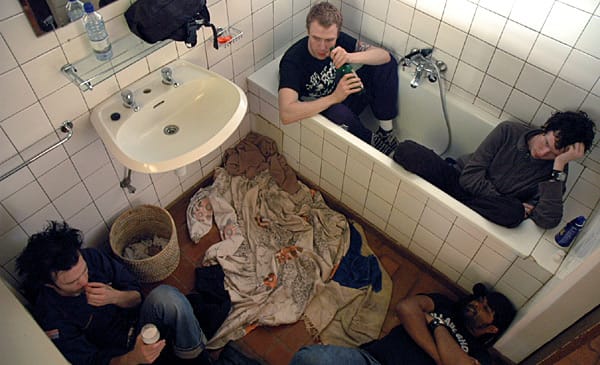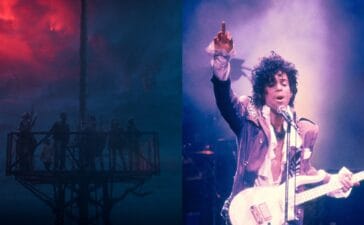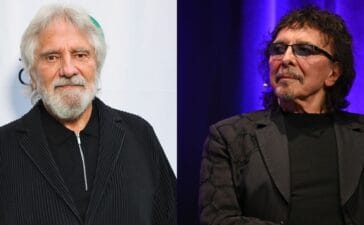The dust was yet to settle on Does This Look Infected?, yet all the signs of a burgeoning punk rock monolith were beginning to show for Sum 41. The band was already experiencing the dizzying heights of success few punk rock outfits ever reach, and it was from this position that Sum 41 decided to risk everything for a good cause.
The year was 2004.
Facebook and Twitter were just emerging from the primordial ooze of the digital realm and Myspace was, well…Myspace. As such, it’s safe to say that if you blinked at some point during this era, there’s every chance you missed the most important event to have come from the alternative community: the time Sum 41 visited the Democratic Republic of the Congo to expose the atrocities and tragedies hidden within.
The end result was Rocked: Sum 41 In The Congo, a documentary made in collaboration with NGO War Child Canada. It’s a story that culminates with the band under siege in a hotel room, taking shelter in bath tubs, as warring militias bombarded their surroundings.
“They almost paid with their lives to tell that particular story”, Executive Producer of War Child Canada, Dr. Samantha Nutt recalls of Rocked: Sum 41 In The Congo to Blunt Magazine.
“My job was really to brief them and to provide them with information and to answer their questions, and also to make sure to steward some of the interviews; to make sure that everything was being handled in a sensitive and appropriate way.”
By 2004, the Congo and its people had been left devastated by an 8 year civil war, resulting in more than a million refugees and hundreds of thousands of deaths; the latest in centuries of conflicts and sub-conflicts to have scarred the region. A peace treaty had been signed by this point, but it was an uneasy peace at best.
“Even though there’s been a peace deal, you just don’t know; it’s still a simmering conflict.”
How did War Child convince an internationally successful punk rock band into entering one of the most volatile conflict zones on the planet? They didn’t. In fact, armed with their aforementioned profile, their collective sense of justice and their anti-authoritarian punk rock sensibilities, Sum 41 came up with the idea on their own.
“I was very honest with them” Dr. Nutt says. “I said look, of all the conflicts that would benefit from this kind of activism and attention, [the situation in the Congo] is definitely one of them. But, I said, it’s also the one that’s the most unpredictable. Even though there’s been a peace deal, you just don’t know; it’s still a simmering conflict.”
“I explained to them that we weren’t interested in doing the kind of typical “Celebrity-goes-to-a-different-part-of-the-world, uses-that-celebrity-to-draw-attention-but-it’s-usually-about-the-celebrity”. We said to them ‘What our vision is for this is you go, you’re functioning effectively as journalists, you’re educating your audience back home, you have to be smart and articulate on the issues and it’s not about your vague emotional experience – we’re not interested in that.'”
Just a couple of months later, they were on a plane to the Congo. The team consisted of Sum 41 members Deryck Whibley, Dave Baksh, Cone McCaslin and Steve Jocz as well as Director Adrian Callender and two war zone doctor veterans, Eric Hoskins and Dr. Nutt.
After introductory discussions with officials to learn more about the conflict, which traces its roots back to the 1994 Rwandan Civil War that eventually bled across neighbouring borders and an estimated 3-4 million civilians paying for it with their lives, Sum 41 began their harrowing sojourn.
On day one, they document Eastern lowland gorillas, one of the oft-forgotten casualties of the conflict due to poaching and mining for raw materials. They then meet Alladin, a self-described raw minerals businessman who deals in Coltan, a mineral used in most electronic devices and largely viewed as a main source of contention in the region given that Coltan, mined and sold by warring factions, is used to fund further fighting.
On day four, they visit a rehabilitation centre for war affected youth that supports child soldiers and young girls who were victims of sexual violence. On the sixth day, they visit an orphanage for young girls abandoned by their families, often for being accused as ‘witches’.
“They really brought an issue forward, in ways that nobody had yet and nobody has since.”
The conversations they had are raw and honestly difficult to watch. Dr. Nutt explained what it was like to look on at these young punk rockers from the suburbs of Canada, clad in Pennywise and Me First And The Gimme Gimmes merch, having such devastating conversations in earnest.
“Honestly, it really was amazing. These guys are really smart. They showed up and they were very, very well read.”
“To see them really trying to convey that deep frustration; that all of this is happening and so few people even know about it…and so few people care about it, but they should and here’s why, and watching that transpire… Honestly, it was one of the highlights of my life and my professional career. Because they really brought an issue forward, in ways that nobody had yet and nobody has since.”
“This isn’t as simple as going out and buying a Prius. This is the real deal. This is not virtue signalling. This is getting it done and putting everything on the line.”
It was on the evening of the sixth day that Sum 41 stopped reporting on a crisis and became survivors of it.
With no warning, a war zone developed around the band’s hotel. What was thought initially to be construction noise turned out to be machine gun fire, the explosion of rocket propelled grenades and mortar fire. Keeping the cameras rolling, the documentary captures the band taking shelter at the request of UN Peacekeepers who are scrambling to assess the situation as the band and their team anxiously awaited an emergency evacuation.
“The building right next to the building that we were in was attacked.”
“We all, at various moments there, thought we were going to die” says Dr. Nutt.
“They organised the evacuation for two reasons. One, because things had really intensified and we were a large number of civilians trapped in the same location. But the other reason is because the building right next to the building that we were in was attacked.”
So far the band had more than proven their integrity, but in the fog of the skirmish, Dr. Nutt recalls yet another moment when the band’s authenticity shone through.
“When things got really, really intense, we said, “Look, stop filming. We’re all too stressed…This is not a good time for anybody to be talking about what they’re thinking and feeling.” And it was the guys who turned around and said: “Keep filming. Because if anything happens to us, we want this to have been worthwhile. We want people to know what happened.”
By the eighth day, the band were evacuated from the hotel in armoured personal carriers thanks to Canadian UN Peacekeeper Chuck Pelletier, who the band honoured with their next album, released that same year: Chuck.
16 years have passed since Sum 41’s visit to the Congo. The band still works with War Child in various ways, but no other punk bands have returned. That has nothing to do with the situation in the region improving. When the documentary was filmed, the Congo had more child soldiers than any other nation. It still does.
Perhaps it’s a case of the genuine rawness and terror of what happened to Sum 41 filling other bands with fear rather than inspiration.
“There are some people who would watch that documentary and go, ‘Oh my God. That was really important and really brave and I can’t believe they did that.’ Dr. Nutt theorises. “And then there are other people who would look at it and go, ‘I can’t believe they did that. I would never do something like that. I would never have the guts to do it,’ and I think most people fall into the latter category.”
After 2004, the Congo was gripped in yet another conflict, the Kivu conflict, which continues to this day. Hundreds of thousands of civilians have died and more than 1 million have been displaced. And there’s no end in sight.
Were another popular band to emulate the Rocked: Sum 41 In Congo mission in this era, the message would be amplified a million-fold; it would go viral, and could be the very lens through which the Western world can refocus their attention to the plight of the Congo. That much is almost certain.
What’s not so certain is who will rise to the occasion.
You can learn more about the work of War Child
and ways that you can help here.
SUM 41 AUSTRALIAN TOUR
with the The Offspring
Tickets available now
Sunday, 19th April
HBF Stadium, Perth
Tickets: Destroy All Lines
Tuesday, 21st April
Entertainment Centre Theatre, Adelaide
Tickets: Destroy All Lines
Thursday, 23rd April
Margaret Court Arena, Melbourne
Tickets: Destroy All Lines
Friday, 24th April
Hordern Pavilion, Sydney
Tickets: Destroy All Lines
Saturday, 25th April
Riverstage, Brisbane
Tickets: Destroy All Lines
Tuesday, 28th April
Spark Arena, Auckland
Tickets: Destroy All Lines










